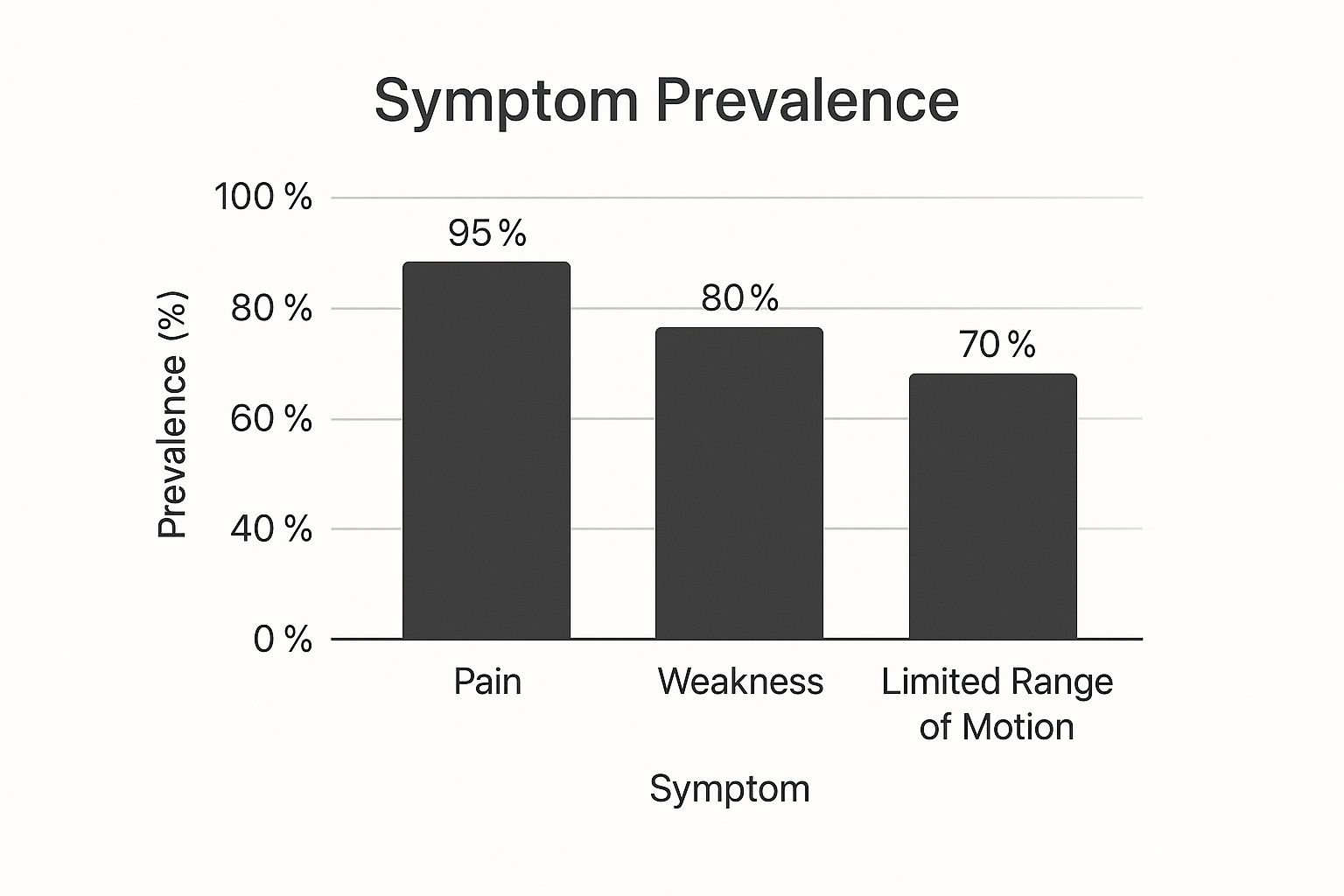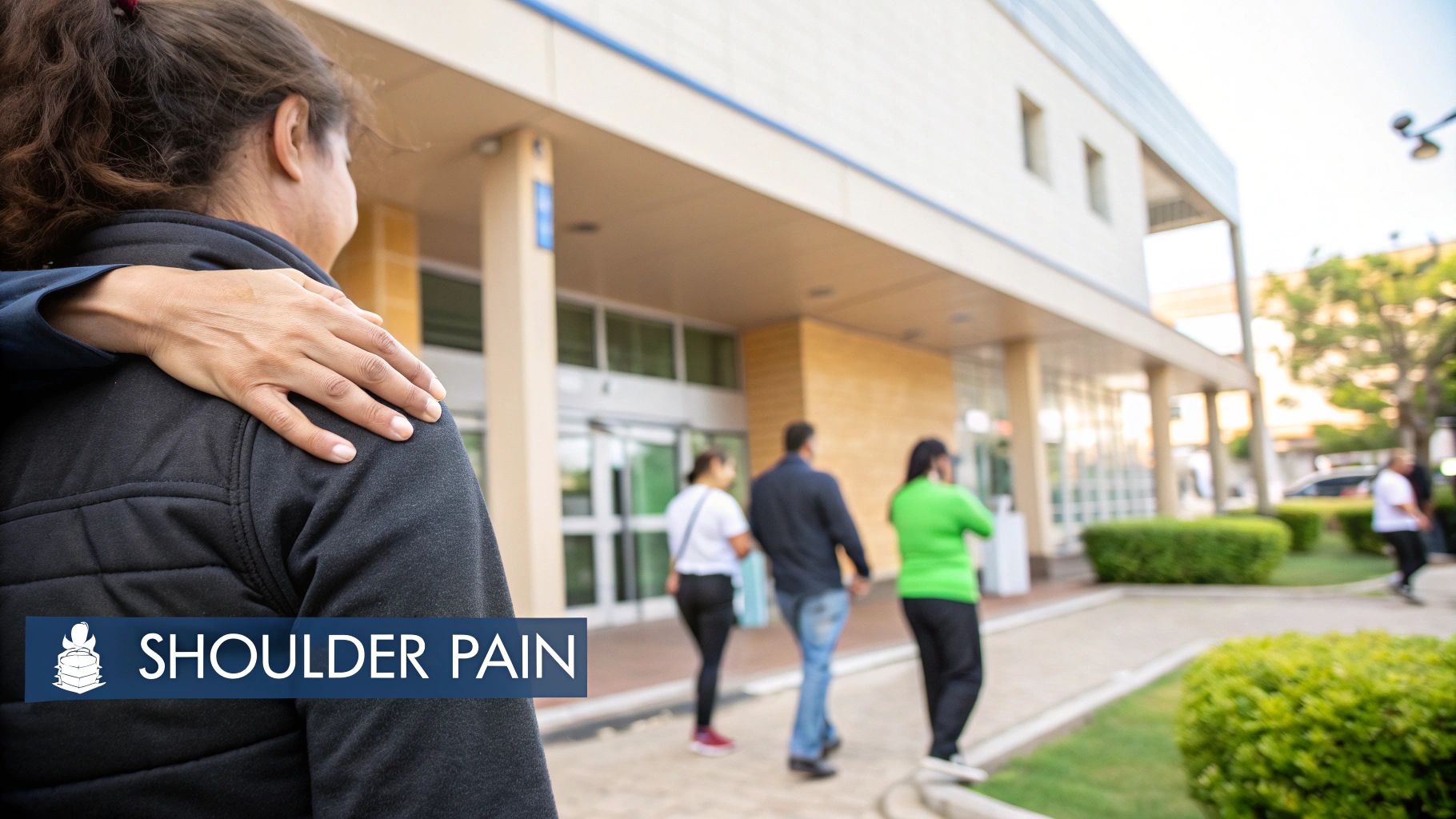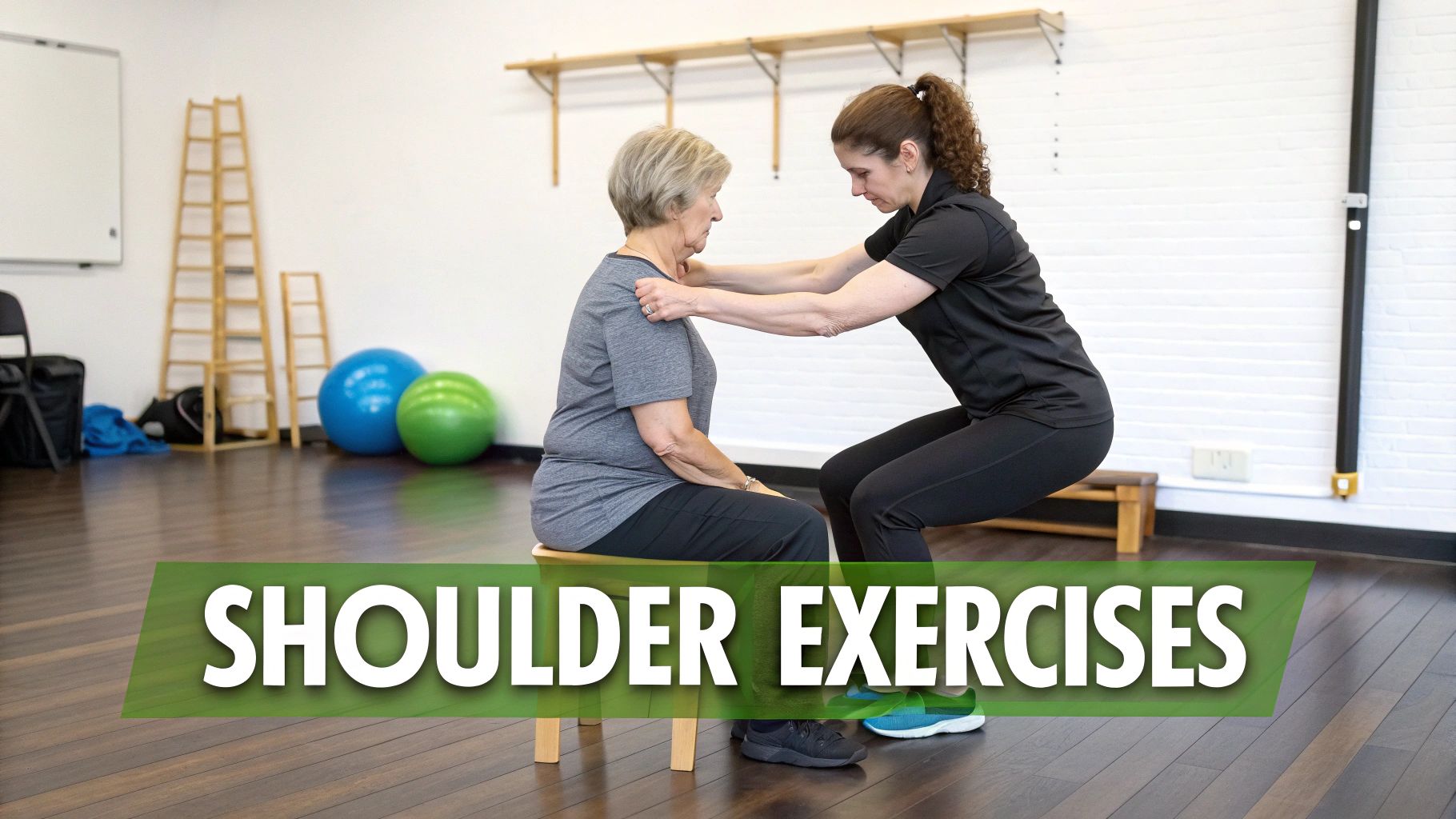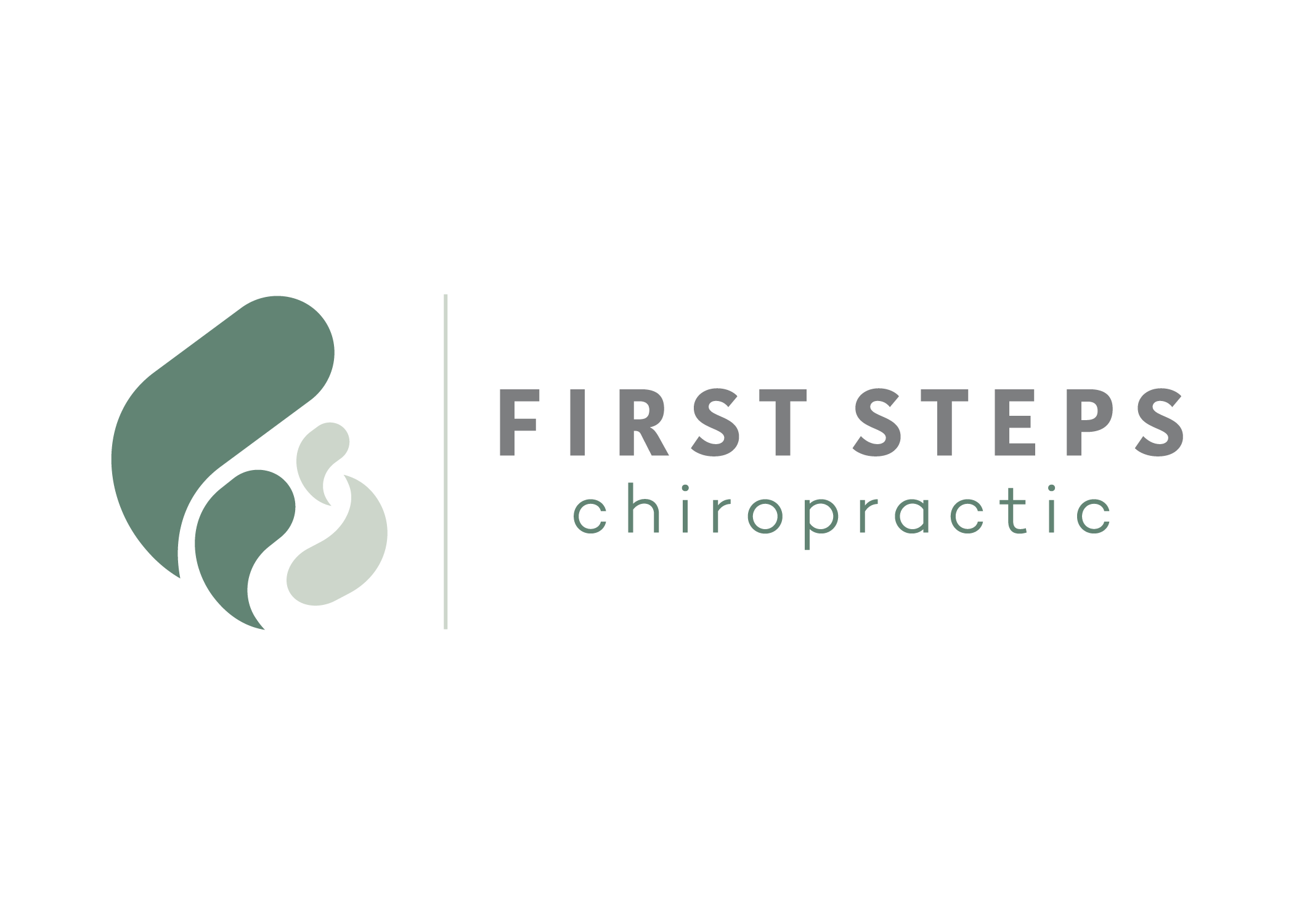If you're dealing with shoulder pain, chances are you’ve wondered if it’s a rotator cuff tear. The classic signs usually include a deep, aching pain right in the shoulder, a very noticeable weakness when you try to lift your arm, and trouble with simple daily tasks like reaching for something on a high shelf.
For many, the pain gets significantly worse at night, especially if you roll onto the injured side. It’s the kind of pain that can really disrupt your sleep.
Decoding Your Shoulder Pain Symptoms
A rotator cuff tear isn't a one-size-fits-all injury. The symptoms can hit you all at once after an accident, or they can creep up slowly over years of repetitive use.
I like to use a simple rope analogy. An acute tear is like a rope suddenly snapping from a forceful pull—maybe from a fall or lifting something way too heavy. On the flip side, a degenerative tear is like that same rope fraying bit by bit over years of wear and tear, until it finally gives way.
Figuring out which type of onset you’re experiencing is the first step toward understanding your pain. An acute injury often comes with intense, immediate pain and sometimes even a popping sensation. A degenerative tear, however, usually starts as a dull ache that just keeps getting worse over time.
Comparing Symptoms of Acute vs Degenerative Tears
The story of how your tear started often gives big clues about the symptoms you'll feel. One is abrupt and alarming, while the other is more of a slow, chronic burn. To make it clearer, let's break down the key differences.
| Symptom | Acute Tear (Sudden Injury) | Degenerative Tear (Wear and Tear) |
|---|---|---|
| Onset of Pain | Immediate, sharp pain following a specific event (e.g., fall, lift) | Gradual, dull ache that worsens over months or years |
| Associated Sensation | A "popping" or tearing sensation at the time of injury | No specific incident; pain often linked to overhead activity |
| Initial Weakness | Sudden and significant loss of arm strength and function | Progressive weakness that slowly impacts daily tasks |
| Night Pain | Often severe and begins immediately after the injury | Develops over time, becoming a persistent, disruptive issue |
This table helps illustrate how two people with rotator cuff tears can have very different initial experiences. One might know the exact moment their injury happened, while the other can't pinpoint a specific cause at all.

As you can see, pain is by far the most dominant symptom. Almost everyone with a tear experiences it. Weakness and a limited range of motion are also very common signs that something is wrong with the rotator cuff.
Why Recognizing Symptoms Matters
Catching these signs early is so important. Rotator cuff tears are one of the most common tendon injuries out there, affecting nearly 23% of the adult population worldwide.
How these tears progress really varies. Some stay small and are manageable with conservative care, but others can grow and lead to significant pain and disability if they're ignored. By paying attention to the signals your body is sending, you can get the help you need before the problem gets worse.
Whether your tear happened in a single moment or developed over time, recognizing the pattern is your first step toward getting the right kind of care. To get a better handle on why these symptoms happen, it helps to understand the shoulder's core anatomy. For a deeper dive, you can also learn more about the rotator cuff in our comprehensive guide.
A Simple Guide to Your Shoulder Anatomy

Before we can really dig into rotator cuff tears, it helps to know who the key players are. I like to use a simple analogy: think of your shoulder joint as a golf ball sitting on a tee.
The "ball" is the head of your upper arm bone (the humerus), and the "tee" is the very shallow socket on your shoulder blade (the scapula). It’s a design that gives us an incredible range of motion, but that freedom comes at a price: stability.
This is exactly where the rotator cuff steps in. It’s not one single thing, but a tight-knit crew of four muscles and their tendons. They come together to form a "cuff" that wraps snugly around the head of your arm bone, holding it securely in that shallow socket. You can think of them as the primary stabilizing team for your entire shoulder.
When you understand this setup, it's much easier to see why a tear causes so much trouble. If one of those tendons gets damaged, the whole system is thrown out of whack.
Meet the Four Muscles of the Rotator Cuff
Each muscle in this group has a very specific job, and they all have to work together perfectly to control every single lift, reach, and twist your arm makes.
- Supraspinatus: This is the one we see injured most often. It sits right on top of the shoulder, and its main job is to lift your arm out to the side.
- Infraspinatus: You’ll find this one on the back of your shoulder blade. It's the muscle that lets you rotate your arm outward—like when you're reaching back to grab your seatbelt.
- Teres Minor: This is a smaller muscle that works right alongside the infraspinatus, also helping with that crucial outward rotation.
- Subscapularis: As the largest of the four, this muscle sits on the front of your shoulder blade. It’s the powerhouse for rotating your arm inward, like when you bring your hand to rest on your stomach.
The rotator cuff's main job is dynamic stability. It constantly adjusts to keep the "golf ball" centered on the "tee" during movement, preventing it from slipping out of place.
When a tear happens, this delicate balance is shattered. The pain and weakness you feel are a direct result of the team losing a key player. The other muscles might try to pick up the slack, but the joint’s stability is compromised, making even simple, everyday movements a painful struggle.
Understanding How Rotator Cuff Tears Happen
A rotator cuff tear rarely just pops up out of the blue. Instead, the injury almost always follows one of two paths: a sudden, traumatic event, or the slow, steady grind of wear and tear over many years. Figuring out which path led to your pain gives us critical clues about the nature of your injury.
One common way tears happen is what we call an acute tear—it occurs in a single, memorable moment. Imagine tripping and instinctively throwing your arm out to break your fall. That sudden, forceful impact can easily overwhelm the tendons. The same goes for trying to lift a heavy box with a jerky motion; that unexpected jolt can be more than the tissue can handle.
The Slow Fray of Degenerative Tears
The second path is far more common, and much more subtle. A degenerative tear is less like a sudden snap and more like a sturdy rope that has been gradually fraying for years. This kind of injury is the result of accumulated stress and tiny bits of damage that weaken the tendon fibers over a long period.
Think about people whose jobs or hobbies involve constant overhead arm movements. A painter reaching up all day, a tennis player serving hundreds of balls a week, or a swimmer pulling through the water—all these repetitive motions place consistent strain on the rotator cuff. Over the years, this strain can create tiny tears that eventually grow larger and more problematic.
A degenerative tear often develops silently. The tendon gets progressively weaker until a seemingly minor action, like reaching into the back seat of your car, becomes the "last straw" that finally brings on noticeable pain and symptoms.
Key Factors That Increase Your Risk
While activity is a big piece of the puzzle, other factors can silently weaken your tendons, making a tear much more likely. Age is the single biggest contributor. As we get older, the blood supply to the rotator cuff tendons naturally decreases, which seriously hampers their ability to repair themselves from daily use.
On top of that, certain lifestyle habits are known to compromise tendon health. These risk factors can speed up the degenerative process, essentially fast-tracking that "fraying rope" effect on your shoulder.
- Age: The natural aging process simply reduces a tendon's elasticity and its capacity to heal.
- Smoking: Nicotine is terrible for connective tissues because it restricts blood flow, starving tendons of the oxygen and nutrients they need for repair.
- Family History: Sometimes, you can't help it. A genetic predisposition can make some people more susceptible to tendon problems.
- Poor Posture: Constantly slouching or rounding your shoulders can pinch the rotator cuff tendons, creating chronic irritation and damage over time.
Understanding these influences is crucial because rotator cuff tears are an incredibly widespread issue. Studies show that between 22% to 39% of adults have some form of rotator cuff tear, with the likelihood jumping dramatically as we age. For instance, roughly 25% of people in their 60s and up to 50% of those in their 80s are affected, which really highlights how much degeneration contributes to the problem. You can learn more by reading these findings on rotator cuff tear prevalence.
How to Recognize the Severity of Your Tear

Realizing you might have a rotator cuff tear is one thing, but it’s just as important to understand that not all tears are created equal. The extent of the damage dramatically influences your pain levels, what you can (and can't) do, and what the road to recovery looks like.
We generally split rotator cuff tears into two main types: partial-thickness and full-thickness.
Picture your rotator cuff tendon as a thick, sturdy rope. A partial-thickness tear is like that rope starting to fray. Some fibers have snapped, but the overall rope is still intact. It’s definitely weaker and it hurts, but it can still do its job, at least to some degree.
A full-thickness tear, on the other hand, is a much bigger deal. This is when that rope snaps completely, creating a hole right through the tendon. In the most severe cases, the tendon can even pull away from the bone where it’s supposed to be attached.
Clues from Your Symptoms
While we need an MRI or an ultrasound to be sure, the way your shoulder feels gives us some powerful clues about what’s going on under the surface. A partial tear often feels like a nagging, persistent ache, but a full-thickness tear usually brings on more dramatic, disabling problems.
Pay close attention to these three key indicators:
- Pain Intensity: Is it a dull ache that only flares up when you move a certain way? Or is it a severe, sharp pain that’s with you all the time, even keeping you up at night? More intense, unrelenting pain often points to a more significant tear.
- Arm Weakness: Can you still lift your arm, even if it’s painful? Or does it feel profoundly weak, like you’re trying to lift a bowling ball? If you struggle to lift a coffee mug or a gallon of milk, that’s a major red flag for a full-thickness tear.
- Range of Motion: Are you just a little stiff, or have you completely lost the ability to do simple things, like reaching over your head or behind your back? A sudden, noticeable loss of your ability to actively move your arm is a classic sign of a more serious injury.
One of the most telling signs of a complete, full-thickness tear is something we call a “drop arm.” If you can manage to lift your arm out to your side but then it just drops uncontrollably when you try to lower it slowly, that’s a strong indicator the tendon is no longer attached properly.
Being able to describe these details to your chiropractor or doctor is incredibly helpful. Pinpointing the intensity of your pain, the specific ways your arm feels weak, and the exact movements you can no longer perform gives us a much clearer picture of your injury. From there, we can build a treatment plan that’s truly designed for you.
When to See a Chiropractor for Shoulder Pain
Most people hear "chiropractor" and immediately think of back and neck pain. But our expertise goes way beyond the spine, covering the entire musculoskeletal system—and that absolutely includes the complex shoulder joint.
If you’re dealing with the tell-tale signs of a rotator cuff injury, knowing when to get professional help is the most important first step. Just trying to push through the pain rarely ends well, especially with a potential tear.
It's time to book a visit if your shoulder pain has been nagging you for more than a week without getting any better. Another big red flag is pain that messes with your sleep or wakes you up at night. And if you feel a noticeable weakness in your arm—making simple things like lifting a mug or combing your hair a real challenge—that’s your body screaming for help.
The Chiropractic Approach to Shoulder Injuries
A chiropractor offers a non-invasive, drug-free path to managing rotator cuff symptoms. Instead of just putting a bandage on the pain with medication, our goal is to get to the root of the problem and fix the underlying mechanical issues causing it. We're essentially helping restore your body's natural ability to heal itself by improving how it functions and moves.
This isn’t just about your shoulder, either. It’s about the whole system—what we call the kinetic chain. We’ll look at how your neck, upper back, and shoulder blade are all working (or not working) together. Stiffness or misalignments in these surrounding areas can easily force the rotator cuff to overcompensate and work way too hard, which is often what leads to injury in the first place.
The core principle is simple: A joint that moves correctly is a joint that feels better. By restoring proper biomechanics, chiropractors aim to reduce strain on the injured tendons, creating an optimal environment for recovery and reducing pain.
What to Expect During Your Visit
Your first visit starts with a thorough examination to figure out exactly what’s causing your pain. A chiropractor will check your range of motion, test your muscle strength, and see if there are any related issues in your spine or ribs that could be contributing. This deep dive ensures the care you get is perfectly tailored to your specific injury.
From there, we'll map out a personalized plan that might include a few different techniques, all designed to restore function and get you out of pain.
- Soft Tissue Therapies: Think targeted massage or trigger point therapy. These techniques are fantastic for releasing all that built-up tension in the overworked muscles around the shoulder. This not only eases pain but also improves your flexibility.
- Chiropractic Adjustments: We use gentle, specific adjustments to the spine and shoulder to correct any misalignments. This improves how the joint moves and takes a significant amount of pressure off those irritated rotator cuff tendons.
- Therapeutic Exercises: You won’t be on your own. We’ll guide you through specific stretches and strengthening exercises to rebuild stability in your shoulder, which is key to protecting it from getting hurt again down the road.
This holistic method is something we apply to the whole family, from the tiniest newborns to older adults. It's the same root-cause philosophy we use to help babies thrive, as we discuss in our guide on finding colic relief for newborns. Seeing a chiropractor for a suspected rotator cuff tear can be a powerful first move in conservative treatment, often helping people avoid more invasive procedures later on.
Your Action Plan for a Pain-Free Shoulder

Alright, we’ve talked a lot about identifying the signs of a rotator cuff tear. Now, let’s get practical and build a plan to fix it. Knowing what’s wrong is the first step, but taking clear, decisive action is how you get back to having a strong, healthy shoulder you can rely on.
Your path to recovery is personal, and it all starts with getting a proper diagnosis from a professional you trust.
Ignoring that nagging pain or weakness is a gamble you don't want to take. Catching the problem early gives conservative treatments the best shot at working, and it might just help you sidestep more invasive procedures down the road. The best approach usually involves a mix of strategies designed to calm the pain, get you moving again, and rebuild your strength from the ground up.
What to Expect on Your Recovery Journey
Think of recovery as a process, not a one-and-done event. It demands patience and sticking to a structured plan. At first, the main goal is to dial down the inflammation and get you comfortable. But the real finish line is restoring full, confident movement to your shoulder.
Your personalized plan will likely include a few key phases:
- Initial Pain Management: This usually means rest, ice, and changing how you do things to give those injured tendons a break. The idea is to stop the pain cycle in its tracks so healing can begin.
- Progressive Strengthening: Once the initial sharpness of the pain has faded, the focus shifts. We’ll introduce carefully chosen exercises to rebuild stability by strengthening the muscles that support your entire shoulder joint.
- Restoring Mobility: Gentle stretches and specific mobility work are crucial for getting back your full range of motion. This prevents the joint from becoming stiff and losing its function over time.
Think of your recovery as a partnership. Your job is to follow the plan and be honest about how you’re feeling. Your provider’s job is to steer the ship with expert care, tweaking the strategy as you get stronger.
Ultimately, you don’t have to navigate this journey alone. It's also worth remembering how interconnected our bodies are. Just as chronic physical pain can wear you down, other life stressors can manifest physically. For example, many people are surprised to learn about the very real physical impacts of mom stress and tension on the body.
Don't wait until the pain is unbearable. Partner with a professional today and start building your roadmap to a pain-free life.
Your Questions About Rotator Cuff Injuries, Answered
When you're dealing with shoulder pain, a million questions can run through your mind. It's completely normal to feel uncertain. Let's walk through some of the most common concerns we hear from patients about potential rotator cuff tears.
Can a Rotator Cuff Tear Heal On Its Own?
This really comes down to the severity of the tear. Many partial and wear-and-tear (degenerative) tears can get much better without surgery. With conservative care like chiropractic and physical therapy, we focus on calming down the inflammation and building up the muscles around the shoulder to give it better support.
However, a big, sudden tear from an injury is a different story. These often need surgical repair to get you back to full strength, especially if you're an active person. If left alone, these types of tears probably won't heal correctly and could lead to ongoing weakness or other joint problems down the road.
What Activities Should I Avoid With a Rotator Cuff Tear?
The best rule of thumb is to listen to your body. If an activity causes a sharp or nagging pain in your shoulder, it's time to stop.
Generally, you'll want to take a break from:
- Lifting objects overhead: Even something simple like putting a dish away on a high shelf can be a major trigger.
- Reaching behind your back: Things you never think about, like tucking in a shirt or fastening a bra, can suddenly become painful.
- Sleeping on the injured side: This puts constant, direct pressure right on the sore spot.
- Repetitive arm motions: Think about sports like swimming or tennis, or jobs like painting. It's best to put those on pause for now.
How Long Does Rotator Cuff Recovery Take?
Recovery time is unique to each person and their specific injury. With non-surgical treatments, some people start feeling a lot better in just a few weeks, but it can easily take several months to feel like you're back to 100%.
For those who have surgery, the timeline is longer. You're typically looking at 4 to 6 months just to get back to basic, everyday activities comfortably. Getting back to demanding sports or heavy-duty work can often take up to a year, as you methodically rebuild that strength and stability.
The real key to a good recovery is patience and consistency. Rushing back to your old routine is a surefire way to risk re-injury. Sticking to your care plan is the most important thing you can do.
Is a Rotator Cuff Tear the Same as Tendonitis?
That's a great question, and no, they aren't the same—but they are related.
Here's a simple way to think about it: Tendonitis is like a rope that's become frayed and irritated from too much use. It’s all about inflammation.
A rotator cuff tear, on the other hand, means the rope has actually snapped—or at least some of its fibers have. While both conditions cause pain, a tear means there's structural damage, which is why it usually leads to more significant weakness and trouble moving your arm. If tendonitis isn't addressed, it can sometimes set the stage for a degenerative tear later on.
At First Steps Chiropractic, our focus is on figuring out the true source of your shoulder pain. We create a personalized plan to help you regain function and get back to doing what you love. Schedule your complementary consultation with us today and let's get started.

